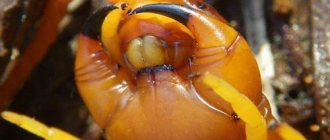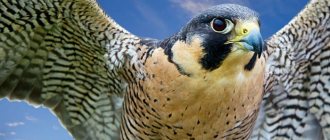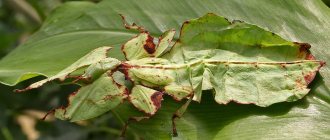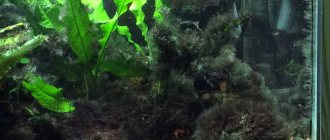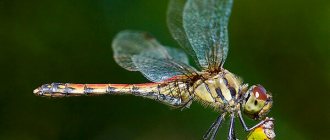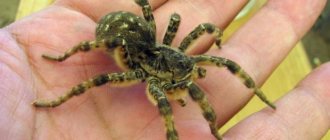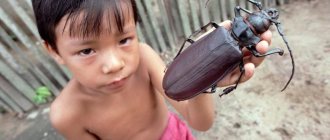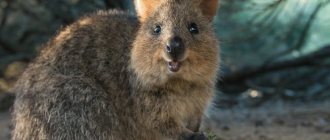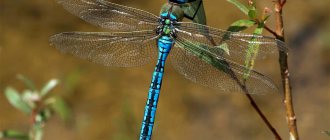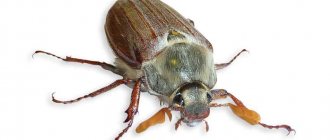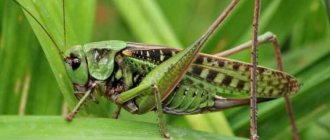Scolopendra is an armored arthropod that belongs to the genus of labiopods, also called Chilopoda or centipede arthropods. It lives in a variety of climates, but prefers tropical climates. Various individuals can live in the desert, mountains, forests, limestone caves and many other places. In those regions where it is not too warm, the centipede grows from a centimeter to ten centimeters in size, but in the tropics an individual can reach 28 centimeters in length!
general description
The giant scolopendra came to this planet, apparently straight from a nightmare. This centipede reaches a quarter of a meter in length, and its body consists of 21–23 sections, each of which is equipped with a pair of fast, dexterous legs 2.5 cm high. Giant scolopendra lives in South America, Puerto Rico and Jamaica.
The head of the centipede is equipped with strong jaws filled with poison - thanks to this, it is able to hunt animals significantly larger than it in size, for example, bats. In addition, the centipede has an irritable and nervous character, which is facilitated by the lack of vision - the animal’s eyes can only distinguish between light and darkness. This makes the centipede rather suspicious, and in response to a threat, it prefers to attack by injecting a paralytic poison into the victim.
When hungry, the scolopendra becomes very aggressive, it is capable of developing great speed when hunting, and the agility and mobility of its body allows it to hunt even small birds. Scolopendra devours its prey gradually, since its digestive system is very primitive. For example, once researchers observed her dining on a killed bat - in 3 hours she devoured and digested about 35% of the victim’s body.
The giant scolopendra is included in the list of the most dangerous animals. In addition, she has a repulsive appearance and has one unpleasant feature - she is not at all afraid of people. It is a cold-blooded predator that hunts not only small invertebrates and beetles, but also lizards, birds, mice and frogs.
Bites and consequences
Scolopendra head close-up.
Labiopods are a striking representative of nocturnal predators. The poison is used during hunting to immobilize the prey. It does not attack a person itself, but bites only in self-defense.
At the site of the bite, two small red dots can be observed. If bitten by a large adult, inflammation may begin. But the bite is quite painful. After a bite, the wound must be treated with an alcohol solution. And then apply a sterile bandage to prevent dirt from getting into the wound.
Sometimes the scolopendra does not bite, but crawls along the body and leaves a mark. The poison is contained not only in the front jaws, but also on the tips of all limbs.
Types of centipedes
There are about 600 species of these predators in the world. They belong to the genus of labiopods from the order Scolopendra. Prominent representatives of these animals are the Californian scolopendra, ringed scolopendra and Lucas scolopendra. The first reaches 20 centimeters in length and is found in arid regions of Mexico and the United States. This species has one unpleasant feature - when disturbed, the animal causes inflammation of human skin at the point of contact with the limbs of this centipede. At rest, the Californian scolopendra is not dangerous.
The ringed scolopendra is found in the countries of the Mediterranean basin, in southern Europe, North Africa and southern Russia. It is widespread in Crimea. The average body length is 14 centimeters, but some individuals reach 170 millimeters. This species has a beautiful golden yellow color. Like other members of the Scolopenridae family, the ringed scolopendra has venom glands.
Habitat
Like most centipedes, scolopendra likes to settle in heat-loving countries with a hot tropical climate. Large populations have chosen the tropical forests of Latin and Central America.
Large specimens can be found in equatorial Africa. In southern Europe there are smaller scolopendras. There are species that settled in the Crimea, steppe zones of Russia, Ukraine, and the countries of Central Asia.
4
Lifestyle
Giant scolopendra, like all other representatives of the genus of centipedes, is thermophilic and lives exclusively in countries with warm or tropical climates. This is a nocturnal predator that feels uncomfortable in open spaces during the day. All scolopendras run very fast, but the giant one is especially swift.
Scolopendras live mainly underground or in shelters, since their body does not have strong protection and quickly loses moisture.
She prefers to hunt small underground invertebrates: larvae, earthworms and beetles. Giant centipede can catch and kill small lizards, frogs, birds, mice and even small snakes. The predator also catches bats. To do this, she climbs onto the ceiling where the victim sleeps, holds on to the surface with several claws, and attacks with her front legs, wrapping herself around the bat and injecting poison into it.
Scolopendras are bright individualists and prefer to live alone. However, the meeting of two males most often occurs quite peacefully. Cannibalism occurs in this species of centipede. Most often this happens in captivity, when a hungry adult is able to eat the young. In nature, this happens quite rarely.
Bottom line
So we learned about these amazing arthropods that look like huge worms with legs. There are people who put scolopendra as a tattoo on their body. And the interpretation is quite simple - such tattoos are applied by people with a rebellious character, going against generally accepted norms. The editors of most-beauty.ru ask you to write in the comments about your attitude towards these animals. Which scolopendras evoke a lot of emotions in you and have you met them in your life?
Anatomy
The scolopendra's body consists of two parts: the head and a long body. It is divided into segments. Their number varies from 21 to 23. All of them are equipped with a pair of light yellow legs that end in a pointed spine. Their average length is 2.5 centimeters. Each of them has a poison gland. Therefore, when the legs of a scolopendra come into contact with human skin, inflammation occurs.
The head is a plate with eyes, two antennae and a pair of jaws. During the evolution, the legs of the first segment of the scolopendra's body turned into poisonous claws.
The last pair of legs is also different from the rest - they are larger in size and directed backwards. The hind legs help the animal when moving through earthen burrows and during hunting, acting as a kind of anchor.
Giant scolopendra has a beautiful copper-red or brown color. Color can vary from yellowish to red, blue, green and purple. The color of an animal changes with age, and even among individuals of the same species it can differ significantly.
The predator's body consists of plates that are connected to each other by flexible membranes and protected by an exoskeleton. Giant scolopendra is a soft-bodied animal. This type of centipede, like many invertebrates, has to shed its chitinous exoskeleton, which does not grow, from time to time. This process is called molting.
Social structure and reproduction
Photo: Black centipede
Scolopendras become sexually mature in the second year of life. They begin to reproduce in mid-spring and do not finish throughout the summer. After the mating process has passed, after a couple of weeks the female begins to lay eggs. The ideal place for laying eggs is considered damp and warm. On average, a female produces from 40 to 120 eggs per clutch, but not all survive. Females monitor and take care of their clutches, covering them from danger with their paws. After the ripening period, small worms are born from the eggs.
At birth, baby centipedes have only four pairs of legs. With each molting process, the little scolopendra adds paws. Until a certain age, the mother remains close to the offspring. But baby centipedes very quickly adapt to their environment and begin to live independently. Compared to other invertebrate representatives, invertebrates are truly long-livers. Their average life expectancy is 6 – 7 years.
There are three stages of development and maturation of centipedes:
- embryo. A stage whose duration lasts one or one and a half months;
- nymph. This stage also lasts from one to one and a half months;
- juvenile The stage reached by the little scolopendra after the third molt;
- Over time, the color of the head changes to a darker color, and the plate becomes easily distinguishable from the body. Young scolopendras begin to live independently at the end of the third week. The scolopendra becomes fully mature only in the second or fourth year of life.
The development of centipedes and its speed depends on climatic conditions, nutrition, humidity and temperature. Each type of centipede has its own life expectancy. Once mature, individuals, depending on the species, can live from two to seven years.
Maintenance and care
The giant scolopendra, whose bite is extremely painful for humans, is often kept in captivity by centipede lovers. She is interesting to watch, but needs to be kept with caution - she is a fast and aggressive animal. Inexperienced lovers are better off abandoning such a dangerous “pet” because of the very likely possibility of being bitten. Since centipedes are flat and flexible, they can squeeze into a small gap and escape from the terrarium. They live in captivity for a long time - up to 7 years.
It is necessary to maintain relatively high soil and air humidity - animals are very sensitive to this indicator.
Centipedes in captivity feed on cockroaches, mealworm larvae and crickets. They eat slowly and infrequently. It is recommended to give them food 1-2 times a week.
Features of character and lifestyle
Photo: Scolopendra in the Krasnodar region
Scolopendra is a poisonous predatory insect that is a dangerous enemy for many insects and small animals. By biting its victim, the scolopendra paralyzes it with poison and slowly eats it. Since the centipede is active at night, it is more productive to hunt at this time of day. During daylight hours, the scolopendra itself hides from enemies so as not to become lunch for others, although during the day it is also not averse to feasting on it.
Centipedes prefer an antisocial life, so they live alone. The centipede shows aggression towards its relative extremely rarely, but if there is a fight between two individuals, one of them dies in any case. In relation to the surrounding world, scolopendra, as a rule, does not show friendliness. This is a nervous and angry insect, whose anxiety is caused by its eyes’ sensitive perception of the light and colors of the surrounding world.
Therefore, any animal or insect that disturbs the scolopendra automatically becomes its target for attack. It is almost impossible to escape from a centipede because it is very fast and agile. In addition, the centipede's digestive system, which digests food very quickly, requires constant replenishment of food supplies. Because of this, the scolopendra constantly needs to look for food.
Interesting fact: The Chinese scolopendra digests slightly less than half of its dinner within three hours.
What are the dangers of meeting a centipede?
The danger of these predators is greatly exaggerated. All centipedes have venomous glands that produce poison, but many of them are harmless to humans because they simply cannot bite through the skin. These are cryptops, or blind centipedes, and drupes. A flycatcher living in houses can bite only for the purpose of self-defense. Most often, her jaws cannot bite through the skin. But if this happens, the bite will be equal in strength to a bee.
What does a scolopendra bite look like? It depends on the type of centipede. When the animal bites through the skin, it releases poison, which causes burning, pain and swelling. The bite may also be accompanied by nausea and dizziness.
The venom of the giant scolopendra is especially toxic. It causes severe swelling (the arm may swell up to the shoulder) and high fever. These symptoms persist for several days.
Video: Scolopendra catches and eats a mole cricket
The only documented case of death from a scolopendra bite is the death of a child from the venom of Scolopendra subspinipes. This species has several names: Chinese, Vietnamese or orange centipede.
Some species of these predators, when disturbed, secrete a protective fluid that causes burns when it comes into contact with the skin. For example, the Californian scolopendra has this feature.
After a centipede bite, you need to wash the wound, apply cold water and consult a doctor. Usually, analgesic drugs are prescribed and tetanus is prevented.
Female centipedes pose the greatest danger (they are more poisonous) to small children, people with weakened immune systems, and people with allergies.
Centipede bite: what does it look like, is it dangerous for humans?
The bright color of centipedes indicates the poisonous nature of the insect. An insect bite can be compared to a wasp or bee sting. In terms of pain, one scolopendra bite can be equated to 20 bee stings. The poison does not lead to the death of a person, but the danger of death still exists if a person is allergic to scolopendra venom.
In the photo - a scolopendra bite mark
There are many opinions in the literature about the real sizes of centipedes. According to known facts, the largest scolopendra is located in Brazil. Its body length is 33 cm. Many claim that the bite of a giant scolopendra is fatal, but this is only known from words.
In Russia, you can meet scolopendra only in the regions - the Caucasus, Rostov region, Krasnodar region, Crimea. There are small individuals there - up to 14 cm, mostly ringed scolopendra, which goes out hunting at night and is not particularly aggressive towards humans. You can meet it completely by accident, for example, in a tent, in a sleeping bag, or while collecting firewood for a fire. In such cases, the scolopendra may begin to defend itself and bite you; its plans did not include a targeted attack on a person.
What to do if you are bitten by a scolopendra?
The sting of a scolopendra is comparable to the sting of 20 bees at the same time, it is quite painful. Scolopendra venom acts immediately, leaving the skin red and painful.
It is best to prevent the centipede from biting or touching human skin with its legs, but if this happens, follow these rules:
- wash the area of contact or damage with soap and water, disinfect with alcohol;
- apply a sterile bandage for 12 hours, then change to a fresh one;
- give the victim plenty of clean water to drink;
- provide peace;
- do not drink alcoholic beverages, they speed up the metabolism and the effect of poison;
- seek help from a doctor.
Pregnant women, children, the elderly, allergy sufferers, and heart patients should urgently go to the hospital, otherwise the outcome can be tragic, even death.
Remember, scolopendra itself does not attack a person. If she notices you, she will rather try to run away with all her legs. But if she accidentally crawls under your clothes or into your tent, and you scare her, then in self-defense she will bite you.
Facts: all the most interesting things about the predatory centipede
- It is difficult to kill this predator. Firstly, all types of centipedes run very fast. Secondly, they are so flat that they simply press into the ground, and it is almost impossible to crush them.
- Even the ancient Greeks called all types of centipedes scolopendras.
- In South Africa, the rhizida lives - a blue scolopendra.
- In Thailand and Africa, these animals are eaten.
Scolopendra in Russia and Belarus
Each species of scolopendra has its own habitat. In Russia and Belarus you can also find labiopods. A particularly large number of them are noted in the Crimea and Transcaucasia. There they prefer to settle in rocky crevices, under stones on the coasts. But in Central Asia, given the hot climate, they are more often found under the roots of trees.
Where does the centipede live?
Photo: Centipede in Russia
Centipedes are found in abundance in countries and regions with temperate, hot climates.
Its natural habitat is:
- the entire Middle East, northern Africa, central and southern Europe;
- southern regions, central Russia, Volga region;
- Ukraine, the entire Caucasus, Kazakhstan and Moldova;
- Mediterranean countries, India.
For reproduction and normal life, centipedes need moisture. In forests it is easy to find under almost any stone, at the roots of trees, among fallen leaves. With the onset of autumn, these creatures look for warmer, secluded places and quite often appear in human dwellings. They most often do not live permanently in apartments and houses, but only wait out the cold. In winter they hibernate, but with the first warmth they come to life and move to their natural habitat.
In human dwellings, flycatchers can be found:
- in basements and cellars;
- bathrooms;
- any rooms with high humidity.
Interesting fact: Penetrating into a living space through cracks in the walls or through a pipeline, centipedes live only in one specific place and do not move. They do not multiply to incredible numbers like cockroaches, and do not spoil food, furniture, flowers, and so on.
Sometimes flycatchers appear indoors even in summer. They can be attracted by various insects that live in abundance in human housing due to unsatisfactory sanitary conditions.
How to deal with it
Despite the positive qualities that insects have, not every person can see them in their home. Insects, no matter how useful they are, provide too little pleasure. The fact that an insect can bite does not make it a good neighbor for humans. Getting rid of the centipede that lives with you at home requires a lot of effort, but initially you need to determine the reasons why it appeared in the house.
If a centipede appears inside a building, in a bathhouse or basement, it is recommended to remove all rotting wood or other organic matter and dry the room. It is also recommended to remove all vegetation and organic waste located near the house. Centipedes are attracted to corrugated cardboard and paper, as well as shredded tree bark and clumps of straw.
Centipedes do not live in large colonies, and if you see one of them, it is advisable to catch it, although this is quite difficult.
For those who do not have time to evict the centipede from the apartment without causing harm to it, an effective method is to use a toxic substance designed to destroy the flytrap.
The best thing is to turn to professionals involved in pest control, but it is worth remembering that in some countries the law is to protect these insects and their appearance in the apartment is considered a blessing.
To get rid of centipedes, you need to remove dead grass and rotten wood
Nutrition
Nature has provided millipedes with anatomical adaptations for successfully catching prey - jaws, a wide throat, poisonous glands, and tenacious legs. Domestic arthropods are called flycatchers for their ability to immobilize insects and then eat for a long time.
It is difficult to escape from a dexterous and agile predator. The ability to run on horizontal and vertical surfaces and quickly respond to any vibration gives her an advantage. Cockroaches, bedbugs, and spiders become food.
The centipede is capable of catching several victims at a time, holding them in its paws, and then eating them one by one. Saturates slowly and for a long time. The bite of the centipede is fatal for most small creatures; cutting up immobilized carcasses is not difficult for the arthropod predator.
Animals living underground are of main interest to forest centipedes. These are earthworms, larvae, beetles. When hunters come out of hiding, they catch grasshoppers, caterpillars, crickets, ants, even wasps.
A developed sense of touch helps predators provide themselves with food. The primitive digestive system requires constant processing of food. Hunger makes the centipede aggressive. Large species of tropical centipedes feast on small rodents, snakes, lizards, and attack chicks and bats.
Those who like to breed centipedes in terrariums need to know that different species cannot be planted in the same container. Predators are distinguished by cannibalism - a strong individual will eat a weak centipede.
Amazing natural flexibility allows these creatures to crawl into the narrowest and most winding places to hide. Therefore, escaping from the terrarium is not a problem for her. The maintenance of arthropods has its own characteristics.
The soil must be moistened so that it is suitable for digging minks. You can add crustacean wood lice to the centipedes; their centipedes will not be touched. Feeding arthropods should be close to nature - crickets, mealworms, cockroaches, insects. The temperature in the terrarium should be maintained at approximately 27°C.
